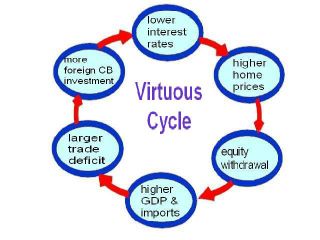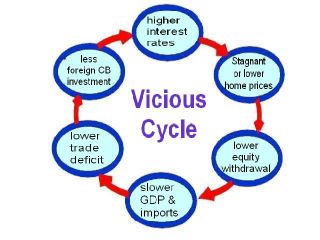by Calculated Risk on 1/24/2006 06:23:00 PM
Tuesday, January 24, 2006
Dr. Setser on Rubin and a Hard Landing
Dr. Brad Setser excerpts from Robert Rubin's Wall Street Journal OpEd and adds some interesting commentary. Setser writes:
Thomas Palley is right: "Foreign flight" (a shock to the United States ability to borrow savings from abroad) is very different from "Consumer burnout" (a slowdown in US demand growth). In both the foreign flight and the consumer burnout scenarios, the US economy slows and the dollar falls. But in the foreign flight scenario, as Palley notes, the fall in the dollar and rise in US (market) interest rates triggers the US slowdown, while in the consumer burnout scenario, the US slump triggers dollar weakness. Foreign flight would combine dollar weakness with higher US (market) interest rates, consumer burnout combines dollar weakness with lower interest rates.A housing market slowdown, and lower mortgage equity withdrawal, might lead to "consumer burnout". This is a potential problem right now for the US economy. But the addition of "foreign flight" might lead to a vicious cycle on the downside.
 Click on diagram for larger image.
Click on diagram for larger image.This diagram is from an earlier post. The diagram depicts a virtuous cycle that might have been occurring over the last few years. Lower interest rates leads to higher housing prices and this leads to more equity withdrawal, higher consumption and more imports. Flush with cash, foreign CBs invest in dollar denominated bonds leading to lower interest rates ... and the cycle repeats.

Unfortunately, as the second diagram depicts, this has the potential to become a vicious cycle as housing slows. As Dr. Setser concludes:
But as US rates start to fall, foreign investors lose interest in lending even more to the US. Rather than adding $1 trillion or so to their portfolio of dollar denominated bonds at 4.5%, they want to add only say $600 billion or so ... Reduced foreign demand for US dollar assets ends up pushing US interest rates up.Of course, this was my top economic prediction for 2006:
At least those interest rates that are set in the market. The Fed's response to consumer burnout could trigger foreign flight.
That is a bad scenario. It implies that the US economy wouldn't benefit from some of the stabilizers that normally buffer the US from really bad (economic) outcomes.
I think long rates will start to rise when the Fed starts cutting the Fed Funds rate.Also, see Dr. Kash's post today: Will the Fed Overshoot?
This will be Bernanke's "conundrum"! As the economy slows, this will reduce the trade deficit and also lower the amount of foreign dollars willing to invest in the US - the start of a possible vicious cycle.


